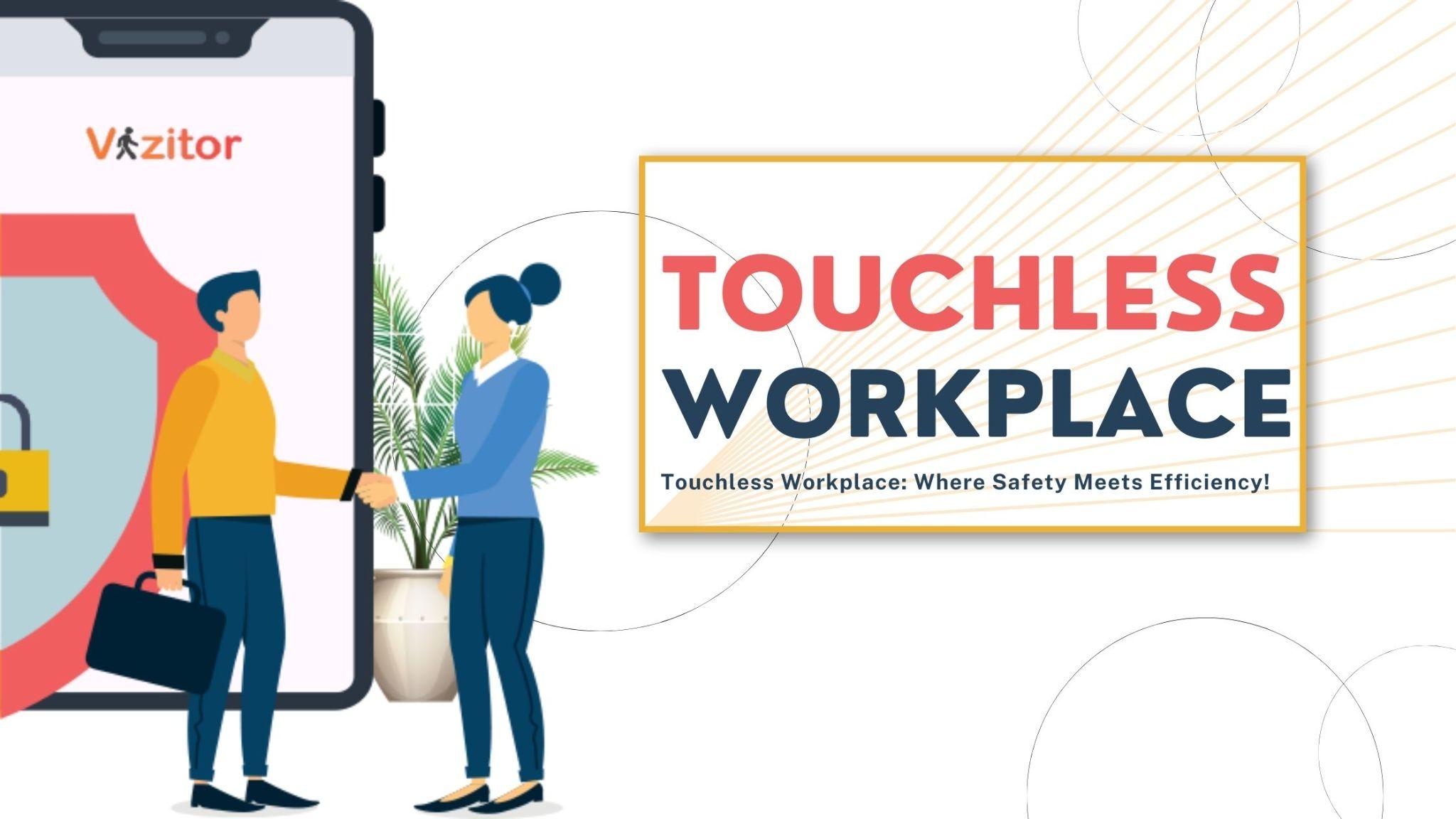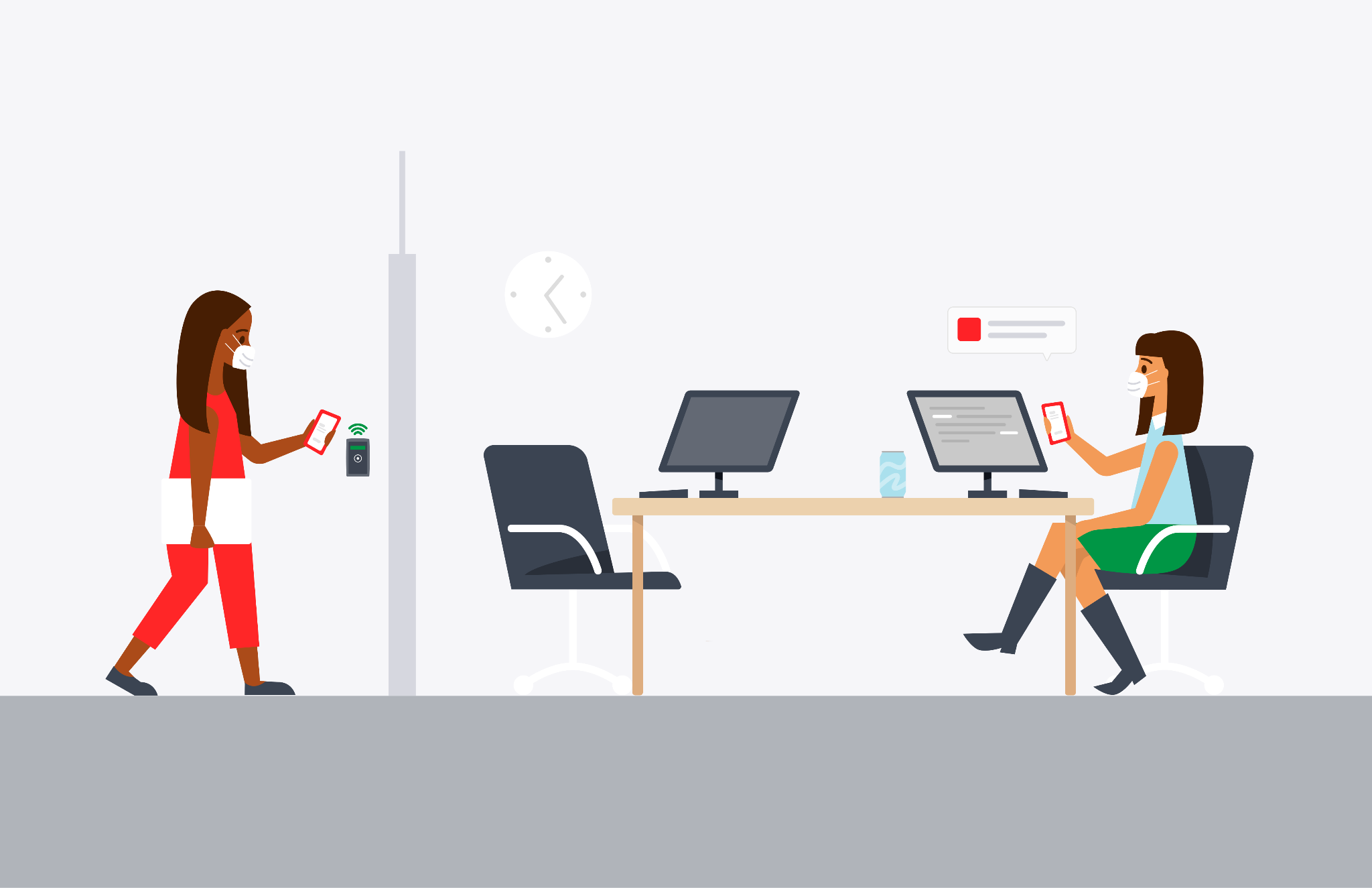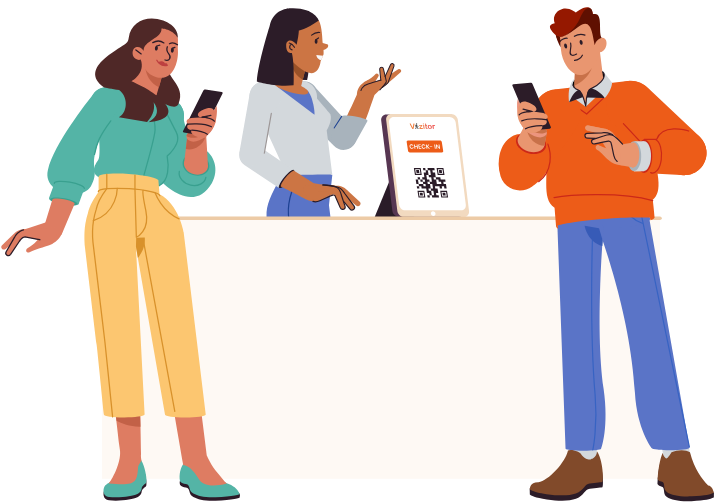Table of Content
Try Vizitor for Free!

Thu, May 30, 2024
Read in 8 minutes
After the global pandemic, workplaces have changed a lot, bringing in the era of the touchless office. Big companies worldwide have quickly adopted touchless technologies to boost safety, make operations smoother, and meet the needs of today’s tech-savvy workers.
With the growing need for cleanliness and efficiency, touchless systems are essential rather than just a future idea. Today’s generation, known for loving technology and easy experiences, is moving to touchless workplaces.
As a result, businesses in many industries are adopting this change to stay competitive, improve productivity, and keep their employees safe. It’s time to see why your office needs a touchless workplace system.
Proven Statistics and Examples
• Amazon: As per India Times, one of the pioneers in touchless technology, Amazon has implemented touchless entry systems and voice-activated controls in its offices and warehouses. This has led to a significant reduction in physical contact points, enhancing safety for employees.
• Google: Google has introduced touchless check-in systems and motion-activated lights in its offices. A survey showed that 87% of Google employees felt safer and more comfortable in a touchless environment, which increased overall workplace satisfaction.
• Microsoft: Microsoft implemented touchless restroom facilities and elevator controls in its buildings. As a result, there was a 40% decrease in the spread of germs and a 30% increase in overall hygiene ratings from employee feedback.
• PwC: PwC adopted touchless visitor management systems and biometric access controls. This transition not only improved security but also reduced the check-in time for visitors by 50%.
• CBRE: According to a CBRE report, 62% of companies have adopted some form of touchless technology post-pandemic. These companies reported a 35% improvement in employee health and a 25% increase in operational efficiency.
What Is Touchless Technology?

Touchless technology refers to systems and devices that operate without the need for physical contact. These technologies utilize sensors, voice recognition, facial recognition, motion detection, and other methods to perform tasks that traditionally require manual interaction. The goal of touchless technology is to enhance convenience, improve hygiene, and increase efficiency in various settings, including workplaces, public spaces, and homes.
1. Key Components of Touchless Technology
• Sensors: These devices detect motion, presence, or other environmental changes. For example, motion sensors can turn lights on or off when someone enters or leaves a room.
• Voice Recognition: This technology allows users to control devices or systems using voice commands. Virtual assistants like Amazon Alexa and Google Assistant are popular examples.
• Facial Recognition: Used for security and access control, facial recognition systems identify individuals based on their facial features, allowing for contactless entry to buildings or rooms.
• RFID and NFC: Radio Frequency Identification (RFID) and Near Field Communication (NFC) are used in touchless payment systems and secure access controls, enabling transactions or entries without physical contact.
• Mobile Integration: Smartphones can act as touchless controllers for various systems, from unlocking doors to starting a car, through apps and wireless connectivity.
2. Applications of Touchless Technology
• Access Control: Touchless entry systems using facial recognition, keycards, or smartphones to grant access without physical contact.
• Payments: Contactless payment methods using RFID or NFC, allowing transactions without swiping cards or handling cash.
• Hygiene Facilities: Automatic soap dispensers, faucets, and toilets in restrooms that activate through sensors, promoting better hygiene.
• Workplace Systems: Touchless check-in for employees and visitors, voice-activated lights, and motion-detected HVAC systems.
• Public Transportation: Touchless ticketing and entry systems in buses, trains, and subways to reduce contact points and streamline boarding.
What Is a Touchless Workplace?

A touchless workplace is an environment where physical contact with surfaces, devices, and systems is minimized or eliminated through the use of advanced technologies. This setup aims to enhance hygiene, streamline operations, and improve the overall safety and efficiency of the workplace. Touchless workplaces have become increasingly important in the wake of the COVID-19 pandemic, as businesses seek to reduce the spread of germs and create safer environments for employees and visitors.
Key Features of a Touchless Workplace
• Touchless Entry and Exit: Employees and visitors can enter and exit the workplace using keycards, smartphones, or biometric systems such as facial recognition or fingerprint scanners, eliminating the need to touch doorknobs or handles.
• Contactless Check-In Systems: Visitors and employees can check in and out using QR codes, mobile apps, or kiosks equipped with motion sensors, reducing the need for physical interaction with receptionists or sign-in sheets.
• Voice-Activated Controls: Voice recognition technology allows employees to control various systems, such as lighting, heating, and air conditioning, without touching switches or panels.
• Automatic Doors and Elevators: Doors and elevators can be equipped with motion sensors or smartphone controls, enabling touchless operation.
• Touchless Restroom Facilities: Restrooms can feature automatic soap dispensers, faucets, hand dryers, and toilets, reducing the need for physical contact with surfaces.
• Digital Communication Tools: Tools like video conferencing, chat applications, and digital collaboration platforms minimize the need for face-to-face meetings and paper-based processes.
What Are The Benefits Of A Touchless Workplace?
Experience the transformative advantages of a touchless workplace, where cutting-edge technologies converge with heightened safety standards to revolutionize efficiency, hygiene, and overall workplace experience.
1. Enhanced Hygiene and Safety:
• Reduced Germ Spread: By minimizing physical contact with surfaces, touchless technologies significantly reduce the transmission of germs and viruses, creating a healthier environment for employees and visitors.
• Lower Risk of Infection: Touchless systems help prevent the spread of illnesses, ensuring a safer workplace, particularly important during flu seasons and pandemics.
2. Increased Efficiency and Productivity:
• Time-Saving: Automated systems, such as touchless check-ins and voice-activated controls, streamline operations and save time, allowing employees to focus on more important tasks.
• Seamless Operations: Touchless technology reduces bottlenecks in processes like entry and exit, check-ins, and meeting room management, enhancing overall workplace efficiency.
3. Improved Employee Experience:
• Convenience: Employees enjoy the ease and convenience of using touchless systems, such as voice-activated devices and automatic doors, which create a more comfortable and user-friendly environment.
• Modern Work Environment: A touchless workplace reflects a commitment to innovation and modernity, which can boost employee morale and satisfaction.
4. Better Security:
• Advanced Access Control: Biometric systems, such as facial recognition and fingerprint scanners, offer enhanced security by ensuring that only authorized personnel can access certain areas.
• Data Security: Touchless systems often include robust security features, protecting sensitive data and ensuring compliance with privacy regulations.
5. Cost Savings:
• Reduced Maintenance Costs: Automated systems often require less maintenance than traditional ones, leading to long-term cost savings.
• Lower Absenteeism: By reducing the spread of illnesses, touchless technologies can decrease employee sick days, leading to higher productivity and lower healthcare costs.
6. Environmental Benefits:
• Energy Efficiency: Motion-activated lighting and HVAC systems ensure that energy is only used when needed, reducing overall energy consumption and costs.
• Paperless Operations: Digital check-ins and communication tools reduce the need for paper, contributing to a more sustainable workplace.
7. Future-Proofing the Workplace:
• Adaptability: Touchless technologies position businesses to quickly adapt to future health challenges and changing workplace trends.
• Innovation Leadership: Companies that adopt touchless solutions demonstrate a commitment to innovation, which can enhance their reputation and competitiveness in the market.
8. Enhanced Customer and Visitor Experience:
• Smooth Visitor Management: Touchless visitor management systems provide a streamlined and professional experience for guests, improving their perception of the company.
• Safety Assurance: Visitors and customers feel more comfortable and assured in a touchless environment, which can enhance their overall experience and satisfaction.
What Rolde Does Vizitor Plays In Touchless Workplace?

Vizitor is a comprehensive visitor management system that plays a pivotal role in creating and maintaining a touchless workplace. By leveraging advanced technologies, Vizitor enhances safety, efficiency, and overall experience for both employees and visitors. Here’s how Vizitor contributes to a touchless workplace:
1. Touchless Check-In and Check-Out:
• QR Code Check-In: Visitors and employees can check in using their smartphones by scanning a QR code, eliminating the need for physical contact with sign-in sheets or kiosks.
• Pre-Registration: Visitors can pre-register online, receiving a unique QR code for a seamless check-in process, reducing waiting times and physical interactions.
2. Health and Safety Compliance:
• Health Declarations: Vizitor allows for health screening questions and temperature checks to be integrated into the check-in process, ensuring that only healthy individuals enter the workplace.
• Contact Tracing: The system maintains a log of all visitors and their interactions, facilitating efficient contact tracing if needed.
3. Enhanced Security:
• Digital Badge Printing: Upon successful check-in, Vizitor can automatically print a visitor badge with a photo, ensuring easy identification without manual handling.
• Real-Time Alerts: Hosts receive real-time notifications when their visitors arrive, allowing for immediate attention and minimizing the need for waiting in common areas.
3. Efficient Visitor Management:
• Visitor Insights: Vizitor provides detailed analytics and reports on visitor patterns, helping businesses optimize their operations and improve visitor management processes.
• Customizable Workflows: The system can be tailored to fit the specific needs of an organization, from security protocols to visitor flow management.
4. Integration with Existing Systems:
• Access Control Systems: Vizitor integrates seamlessly with existing access control systems, enabling touchless entry and exit for visitors and employees.
• Digital Communication Tools: Integration with tools like Slack, Microsoft Teams, and others ensures smooth communication and coordination within the workplace.
5. Improved Employee Experience:
• Easy Host Management: Employees can pre-register their guests, send out invitations with check-in instructions, and manage visitor schedules effortlessly through Vizitor.
• Safe Environment: By reducing physical contact points and enhancing safety protocols, Vizitor contributes to a healthier and safer workplace, boosting employee confidence and morale.
6. Environmental Benefits:
• Paperless Operations: Vizitor supports a fully digital check-in and check-out process, reducing the need for paper-based records and contributing to environmental sustainability.
7. Customization and Branding:
• Custom Branded Interface: Businesses can customize the Vizitor interface to reflect their branding, providing a professional and cohesive visitor experience.
• Tailored Visitor Experience: Personalized visitor workflows ensure that each visitor has a tailored experience based on their purpose of visit, whether for meetings, interviews, or deliveries.





